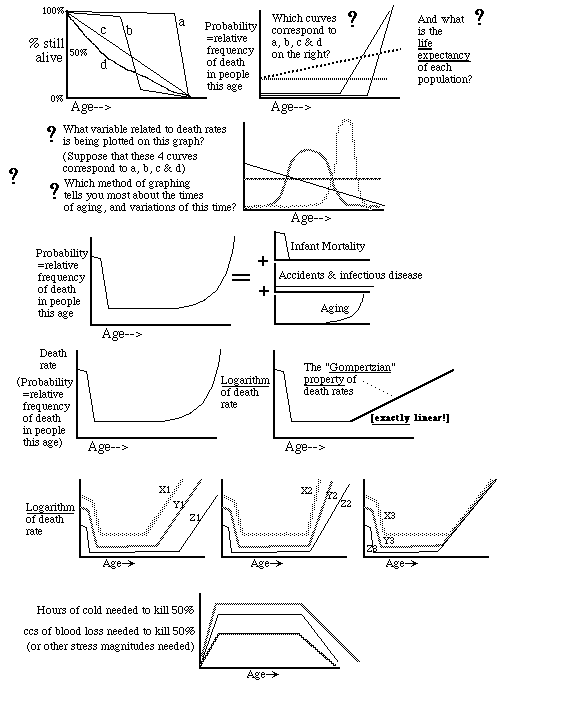Aging
April 15, 2015
The maximum documented lifespan for humans is 122 years; fruit flies live 3 months.Some other typical life spans:
mouse 2 years
rat 4.5 years
hamster 5 years
cow 30 years
elephant 70 years
People often think that with improving medical care, aging has been delayed. A common misconception is that people today live much longer than they did a few hundred years ago. Sometimes people will say that in the 1700s a person of 65 to 75 years old would have been regarded as very unusual, but in fact even the ancient Greeks and Romans often lived to 60, 70 or 80 years old. They didn't get old at earlier ages than people do today (with the partial exception of dentistry, and reading glasses).

"Life Expectancy" give most people the false impression that rates of aging are slower now than the used to be. (Really, life expectancy is more an inverse measure of infant mortality and disease & accidental deaths. It is the age reached by half the population. This might be as low as 10 years old in a population with very high rates of childhood mortality; but survival past age 10 might average 75 years.)
Visualize deaths as divided into 3 categories:
-
(I) A big peak before age 5, especially in poor countries,
and areas without vaccines
II) A low, flat rate continuing through life, resulting from accidents and disease.
III) A big bell-shaped curve, centered on 70 to 80+, which we
define as resulting from aging.
From age 35 to about 85, the rate of death doubles about every 7 years; straight line when plotted on log paper.

Hutchinson-Gilford progeria syndrome and other progerias are very rare diseases in which young children show the changes associated with aging. The cause is mutation in a protein that is part of nuclear pores. Some other conditions of premature aging are caused by defective DNA repair.
Likewise, mice & humans with detective telomeres age prematurely.
Accumulation of mutations in genes for proteins involved in transcription & translation increases the mutation rate, which may cause the autocatalytic increase in death rate during aging.
*************************************************
Error Catastrophe Hypothesis
Disproved by studies of mutation rates of viruses infecting cells
of different ages.
(Mutation rate ought to have been higher in a virus that is infecting,
and using the enzymes for transcription and translation.)
reactive oxygen species -- superoxide ions -- free radical but "evidence hasn't held up"
but cumulative errors in changes on chromatin
Some species of animals age much more gradually than others:
Venus mecenaria (clam) Several species of turtles
Somehow related to continuous growth, also continuous fertility.
Telomeres prevent unraveling of the ends of chromosomes.
"Senescence" of tissue culture cells (when it occurs) is often a result of failed telomeres
===========================================
Paradoxes and clues:
a) ~ 40-fold difference of aging rates among mammals.
b) Some species of clams, turtles, and sea anemones reach ages
of 150 or more
.
(These continue to grow and remain reproductively active)
c) Although small mammals almost always age sooner than large mammals
(Ihe reverse is true of breeds of dogs: very big are old at 6 or 7,
very small live past 20.)
(In no other mammal is there any such correlation)
d) Death rates of humans double every 7-8 years, from 35 to 85, then
increase more slowly.
(Insurance companies keep very large amounts of data on this
"Gompertzian" property)
Certain textbooks deduce that logarithmic increases in cancer rates prove multiple somatic mutations (about 6) must be the cause of this mathematical pattern.
They may be right, but the same statistical pattern is also true of heart disease, kidney disease and death rates as a whole.